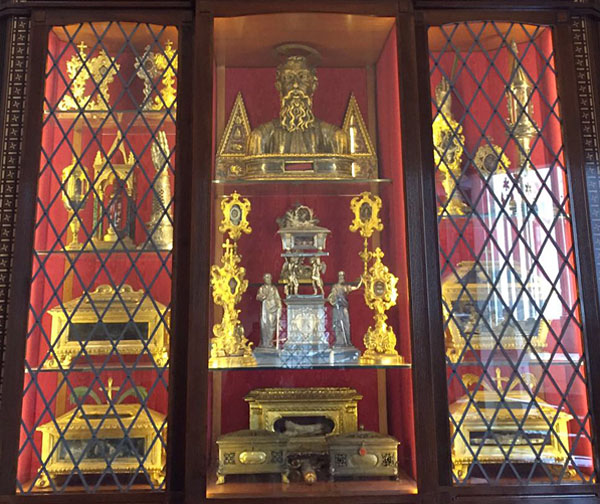One of the principal ways the Church teaches the faithful is through its sacred liturgy. How the Church prays communicates what we believe. The prayers, gestures, vestments, and art work that make up the solemn rites of the Church make visible before our eyes the timeless truths of the Church. Devotion to the saints, and the veneration of their relics, play an important role in the life and liturgy of the Church.
First, the Church’s liturgy teaches that the relics of the saints are to be treated with the greatest respect. As the relics are the bodily remains of holy men and women, it is the practice to place the relics in a location that is safe and secure, where they will not be lost, disturbed, or used in any profane way. In many shrines, the resting place of the saint’s relics are in a sealed casket or urn, giving the faithful the reminder that this the resting place of a deceased person. Further the relics may be incensed during prayers or liturgies, as the body of a Christian is incensed at a funeral Mass. These are clear signs that holy relics are human remains, not good luck charms, items with magic powers, or rare antiques to be kept by private collectors. Also, places where relics are reserved often have a statue or imagine of the saint, fostering a sense of the person being honored and venerated.
Second, the Church seeks to reserve the relics of saints in where the faithful can come and venerate them in person. Even when relics are entrusted to particular persons or groups (ie, royal families, convents, or private chapels), those groups offer opportunities for public veneration on certain hours of the day or on certain feast days throughout the year. Further, relics were often placed in reliquaries with glass windows, so the faithful could see or touch the relic of the saint. Some ancient shrines had holy relics buried in containers with a small opening so the faithful could lower a cloth on a string to touch the bones, and then take the cloth home as a third class relic.
Third, the Church designates the shrine where holy relics are displayed as a place of prayer. Reliquaries are often reserved in chapels, side altars, or quiet areas set apart for prayer. Normally the tomb or reliquary has an altar rail, kneelers, chairs, candles, or oil lamps. These items ensure that there is a sense of a sacred place, and foster an opportunity to invoke the intercession of this holy saint who is now in the glory of heaven. Some shrines provide prayer cards or an official novena in order to promote devotion to the saint. When the relics are those of a person who is not yet a canonized saint, there may also be information on how to contact the postulator of that holy person’s cause, in case of miracles given by that person’s intercession.

Reliquary cabinet at the Cathedral of Saint Mary of the Assumption in Sienna, Italy
********
Lastly, in the Church’s Rite of the Dedication of an Altar, there is a tradition of placing the relics of saints (especially martyrs) into the altar. This continues the ancient custom of erecting an altar over martyr’s tomb, and showing the connection of their death to be in union with the sacrifice of Christ the Lord. The Rite also recommends that a prayer vigil takes place where the faithful can venerate the saint’s relics before the relics are permanently placed in the altar.
By its liturgical laws and traditions, the Church teaches that the intercession of the saints, and the honor given to their relics, assists us in our spiritual life and our pilgrimage to heaven.




 Change language to English
Change language to English